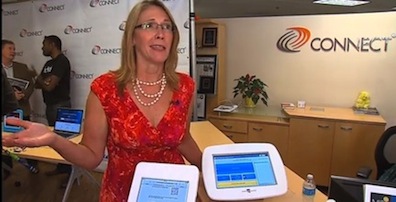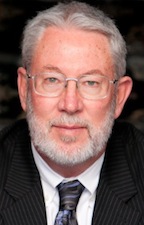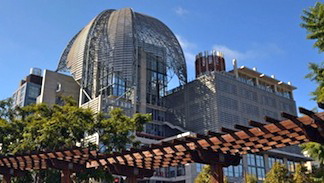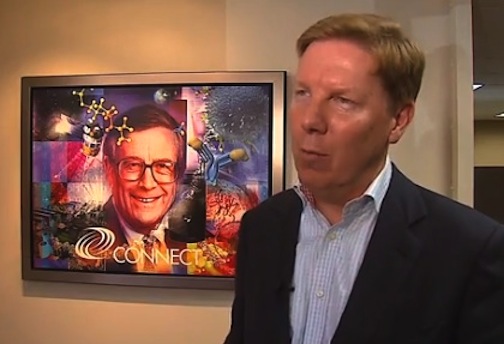Daily Business Report-Sept. 30, 2014
Greg McKee, CEO of Connect, said San Diego accounted for 6,788 patent applications, second only to Santa Clara County, home to Silicon Valley.
San Diego Innovation Economy
Had a Banner Year in 2013
A report Monday underscored San Diego’s status as an innovation hub, finding that last year local entrepreneurs created 412 tech companies employing over 1,200 people.

Connect’s innovation report for 2013 was introduced by Mayor Kevin Faulconer at a press conference at the organization’s offices near UC San Diego in La Jolla.
“San Diego is unquestionably an innovation economy hub in the United States,” said Faulconer, noting that jobs in innovation sectors pay almost $110,000 annually, more than double the average. “Innovation jobs provide a pathway to prosperity,” he said.
Joining Faulconer for the announcement were the leaders of seven startups, including BRAINstorm Golf, Doctible, ElliptiGO, Everyone Counts, FITzee Foods, Innovega and nPruv.
CONNECT CEO Greg McKee said San Diego County accounted for 6,788 patent applications in 2013, second only to Santa Clara County, the location of Silicon Valley. He said that shows the extent of meaningful research being conducted locally and sets the stage for future commercialization.
He said CONNECT is committed to supporting local entrepreneurs and “helping them create and scale great companies.”
The number of tech companies created was the highest in five years, and nearly 100 more than in 2013. Most were in software, followed by computers and electrics, and life sciences, according to the report. A total of $765 million was invested in San Diego startups.
— Times of San Diego
Governor Brown Signs Legislation
To Ban Single-Use Plastic Bags

SACRAMENTO–Gov. Jerry Brown today signed the nation’s first statewide ban on single-use plastic bags — SB 270 — aligning state law with ordinances passed by a growing number of local governments in California to reduce plastic waste.
“This bill is a step in the right direction — it reduces the torrent of plastic polluting our beaches, parks and even the vast ocean itself,” said Brown. “We’re the first to ban these bags, and we won’t be the last.”
The legislation, authored by Senator Alex Padilla (D-Pacoima), prohibits grocery stores and pharmacies from distributing single-use plastic bags after July 2015 and enacts the same ban for convenience stores and liquor stores the following year. It will also provide up to $2 million in competitive loans – administered by CalRecycle – to businesses transitioning to the manufacture of reusable bags.
Thus far, over 120 local governments in California have passed ordinances banning single-use bags in some fashion, with widespread support from community and environmental groups. SB 270 is supported by many of these same groups, along with local governments, businesses and labor organizations.
“The California coast is a national treasure and a calling card for the world, helping us attract visitors and business from around the globe. Removing the harmful blight of single-use plastic bags, especially along our coastline and waterways, helps ensure the kind of clean and healthy environment we need to have a stronger economy and a brighter future,” said Assembly Speaker Toni Atkins (D-San Diego).
“For nearly 10 million Californians, life without plastic grocery bags is already a reality. Bag bans reduce plastic pollution and waste, lower bag costs at grocery stores, and now we’re seeing job growth in California at facilities that produce better alternatives,” said Californians Against Waste executive director Mark Murray.
Battery System With Capacity to Power 2,500
Homes to be Installed at UC San Diego
One of the largest battery-based energy storage systems in the United States will be installed at the UC San Diego the campus and will provide enough capacity to power 2,500 homes.
The 2.5 megawatt, 5 megawatt-hour system will be integrated into the university’s microgrid, which generates 92 percent of the electricity used on campus annually and is considered one of the world’s most advanced microgrids. A microgrid is a small-scale version of a traditional large power grid that controls energy from clean sources such as wind and solar power, as well as from conventional technology. It can be connected to a larger electric grid,
The energy storage system at UC San Diego was purchased from BYD, the world’s largest supplier of rechargeable batteries. BYD’s energy storage system uses high performance lithium-ion iron-phosphate batteries that are known for being highly reliable and environmentally-friendly.
“UC San Diego is committed to practices that promote sustainability and innovation, not just on our campus, but in our community and our world,” said Gary C. Matthews, vice chancellor for resource management and planning.
Energy storage systems are technologies that convert electricity into another form of stored energy and then convert the energy back to electricity at another time. Energy storage is considered so important that the California Public Utilities Commission decided last year to establish an unprecedented energy storage target: 1.3 gigawatts of energy storage is to be procured and installed by three of the state’s investor-owned utilities by 2024.
Breast Cancer Symposium Tonight
Susan G. Komen San Diego will host a symposium on breast health and breast cancer tonight at the Marriott Del Mar. Emmy-winning women’s health advocate and breast cancer survivor Carol LeBeau will lead a panel to help attendees answer important breast health questions. The symposium is titled “Screens, Genes, & The Choices We Make: A Night of Breast Health Awareness.”
The evening will consist of a reception, dinner and discussion about the breast health facts that can keep San Diegans informed and healthy. The panel of experts will include Ardy Arianpour, chief strategic officer at Pathway Genomics; Dr. Jennifer Purdy Mayberry, M.D., diagnostic radiologist and women’s imaging specialist at San Diego Imaging; and Stephanie Birkey Reffey, managing director,for Susan G. Komen. Lorraine Hutchinson, Komen San Diego 2014 Honorary Breast Cancer Survivor, will also share her story.
Arianpour has 13 years of experience in the biotech industry and will discuss the current research on genetic testing including genetic breakthroughs and the ethics and morality of genetic testing.
The event begins with a reception at 5:30 p.m. followed by dinner at 6 p.m. and the program from 6:30 to 7:30 p.m. Tickets are $50. To order, visit www.komensandiego.org.
Boys & Girls Clubs Branch Receives
Grant for New Technology Center
The Oaks Branch of the Boys & Girls Clubs of Greater San Diego received a $25,000 grant from Cox Communications and the James M. Cox Foundation to fund its new Logan Heights technology center. The grant is part of a program by Cox to create seven new technology centers across the country.
The technology centers are the centerpiece of the Boys & Girls Clubs of America Club Tech program, which provides students access to curriculum to advance their computer literacy skills. These technology centers also help bridge the digital divide for children who have no access to a computer or Internet connection at home.
Each Boys & Girls Club Technology Center includes state-of-the-art computers, along with monitors, laptops, printers, docking stations, wireless routers, wireless cards, and proprietary Microsoft and Club Tech software. Through the Club Tech suite of programs, youth learn the basics of business software, plus stay safe online and move on to advanced hardware and networking skills.
Two Councilmen Propose Voluntary
Water Restrictions Become Mandatory
Two City Council members proposed Monday that San Diego’s voluntary water use restrictions — like cutting back on watering the lawn — be made mandatory. Councilmen David Alvarez and Ed Harris asked the mayor’s office to bring such a plan to the council’s Environment Committee, which Alvarez chairs, next week.
“San Diegans have seen the impact of drought conditions in their own backyards and throughout California,” Alvarez said. “We are responding to the governor’s call to reduce use by 20 percent, and we need these tools to reach that level.”
In the spring, the city issued a “Drought Watch” that asks residents and commercial establishments to limit landscape irrigation to three days per week; use shut-off nozzles or timed garden hose sprinkler systems if watering without an irrigation system; use recycled or non-potable water for construction purposes; and refrain from watering lawns or plants when it rains, among other things.
Upgrading to a “Drought Alert” would require residents and businesses to take such measures. Alvarez and Harris said implementing the restrictions now could prevent harsher measures later.
“In addition to continuing with our outreach and education with residents, it is essential that we reinforce that education with enforcement measures,” Harris said.
The councilmen also asked the mayor’s office to hire sufficient staff to enforce the measures.
— City News Service
Rady School Named One of Top
50 Business Schools in the U.S.
UC San Diego’s Rady School of Management has been named one of the country’s 50 most innovative business schools by the business education website Business Management Degree. The schools listed were identified based on their understanding of the importance of what a creative, innovative, leading edge college or university means to its business school attendees, according to Business Management Degree.
“The business colleges and universities noted in this list are the catalysts that are helping to transform the future of business higher education. Through ground-breaking, pioneering ideas and approaches to teaching, the schools have seen the importance of developing curricula that will enhance the learning experience for their students,” the website said.
Four UC San Diego Teams Win Grants
From President Obama’s BRAIN Initiative
Four teams of scientists at UC San Diego will receive research grants from the National Institutes of Health that will help lay the groundwork for visualizing the circuits of the brain and how they work, the agency announced at a White House ceremony today.
They join four other research teams at the university that in August were awarded early concept grants for brain research from the National Science Foundation.
The eight awards were made to fund research projects that the two federal science agencies expect will make transformative insights into understanding how the brain works. The funding comes from each agency’s allocation for President Obama’s BRAIN Initiative, a multi-agency research effort that seeks to accelerate the development of new neurotechnologies that promise to help researchers answer fundamental questions about how the brain works.
The four UC San Diego principal investigators and teams who will receive the awards and their projects are:
• David Kleinfeld, a professor of physics and neurobiology, and colleagues Martin Deschenes of Laval University, Yoav Freund of CSE and Martyn Goulding of the Salk Institute for Biological Studies will deconstruct the neuronal circuits in the brainstem that control orofacial and exploratory actions. The award will total approximately $2.8 million for three years.
• John Lin, an assistant project scientist in the Department of Pharmacology in the School of Medicine, in collaboration with Yishi Jin, professor of biology and HHMI Investigator, at UC San Diego, Mark Mayford at The Scripps Research Institute and Xin Jin at the Salk Institute for Biological Studies, will develop and test protein-based tools that can manipulate cellular events within neural synapses that are believed to mediate learning and memory. The award will total approximately $750,000 for three years.
• Massimo Scanziani, a professor of biology and HHMI lnvestigator, and Carsten Pfeffer, a postdoctoral fellow in his laboratory, will establish a classification scheme of neurons in the cerebral cortex of mammals based on the genes that best predict their function. The award will total approximately $1.8 million for three years.
• Andrew Huberman, an assistant professor of neurosciences, biology and ophthalmology, in a collaborative team with labs led by Sebastian Seung of Princeton University, Markus Meister of Caltech, Rachel Wong of the University of Washington and Thomas Euler of the University of Tubingen, will define all the cell types and synaptic connections that link the eyes to the brain and probe using state-of-the-art genetic and imaging tools how those cells contribute to visual perception and behavior. The award will total approximately $4.1 million for three years.
Attorney Michael O’Halloran Receives
State Bar President’s Pro Bono Service Award

Michael O’Halloran, a volunteer with the San Diego Volunteer Lawyer Program, has been honored as one of the recipients of the 2014 California State Bar President’s Pro Bono Service Awards. The award recognizes California attorneys, law firms, associations of California attorneys, law schools and law students who have provided or enabled the direct provision of legal services to low-income clients or to nonprofit organizations whose primary purpose is to provide services to the poor or disadvantaged, free of charge, without expectation of compensation, in the preceding calendar year.
O’Halloran is founding partner at the Law Office of Michael T. O’Halloran and his practice focuses on complex bankruptcy matters.
O’Halloran volunteers his services to SDVLP throughout the year, at SDVLP’s annual Women’s Resource Fair , and with SDVLP at the San Diego Veterans Stand Down annual event.

Downtown Library Sees Doubling of Patronage
Patronage of the San Diego Central Library has more than doubled since the landmark facility near Petco Park opened to the public one year ago Tuesday.
Over the past year, attendance at the new nine-story facility on Park Boulevard totaled approximately 1 million people, compared to 456,000 in the final year of the old location on E Street, according to figures provided by the San Diego Library Foundation. Circulation figures are also believed to be doubled, but the numbers aren’t final.
About 3,000 people per day are using the 550,000-square-foot Central Library, and 45,000 new library cards have been issued in the past year.
The $185 million library was built three decades after city officials determined the old building was becoming obsolete. Funding problems, delays in finding a site and debates over whether a big main branch was necessary in a sprawling metropolis during the Internet age combined to slow the start of the project.
The Central Library concept was eventually boosted by East Village development, the population growth of downtown, fundraising by the library foundation and a deal with the San Diego Unified School District to place a charter high school on the upper floors.
The facility includes a 350-seat auditorium, a three-story domed reading room, a children’s room of around 9,100 square feet, a teen center, a technology center and a multi-purpose room. It also features an outdoor garden courtyard and cafe, 250 parking spaces on two levels, and dramatic views of downtown and San Diego Bay.
The library foundation plans to host a gala on Oct. 10 at the library to raise funds for technology and programming at all library locations.
— City News Service
Home Price Increases Slow
Slow in San Diego, Nationwide
Home price increases are slowing across the country, with San Diego showing a rise of only three-tenths of a percent from June to July, and 8.3 percent for the past 12 months.
Data released Tuesday for the S&P/Case-Shiller Home Price Indices, a leading measure of U.S. home prices, shows a significant slowdown in price increases.
Nineteen of the 20 metropolitan areas saw lower annual increases in July. Las Vegas, Miami and San Francisco were the only ones to still report double-digit annual gains. Here is how California’s largest metro areas fared:
• San Francisco – 10.3 percent
• Los Angeles – 9.0 percent
• San Diego – 8.3 percent
• U.S. Average – 5.6 percent
Home prices in San Diego rose 0.3 percent from June to July, down from 0.6 percent from May to June.
“The slower pace of home price appreciation is consistent with most of the other housing data on housing starts and home sales. The rise in August new home sales — which are not covered by the S&P/Case-Shiller indices – is a welcome exception to recent trends.”
— Times of San Diego


